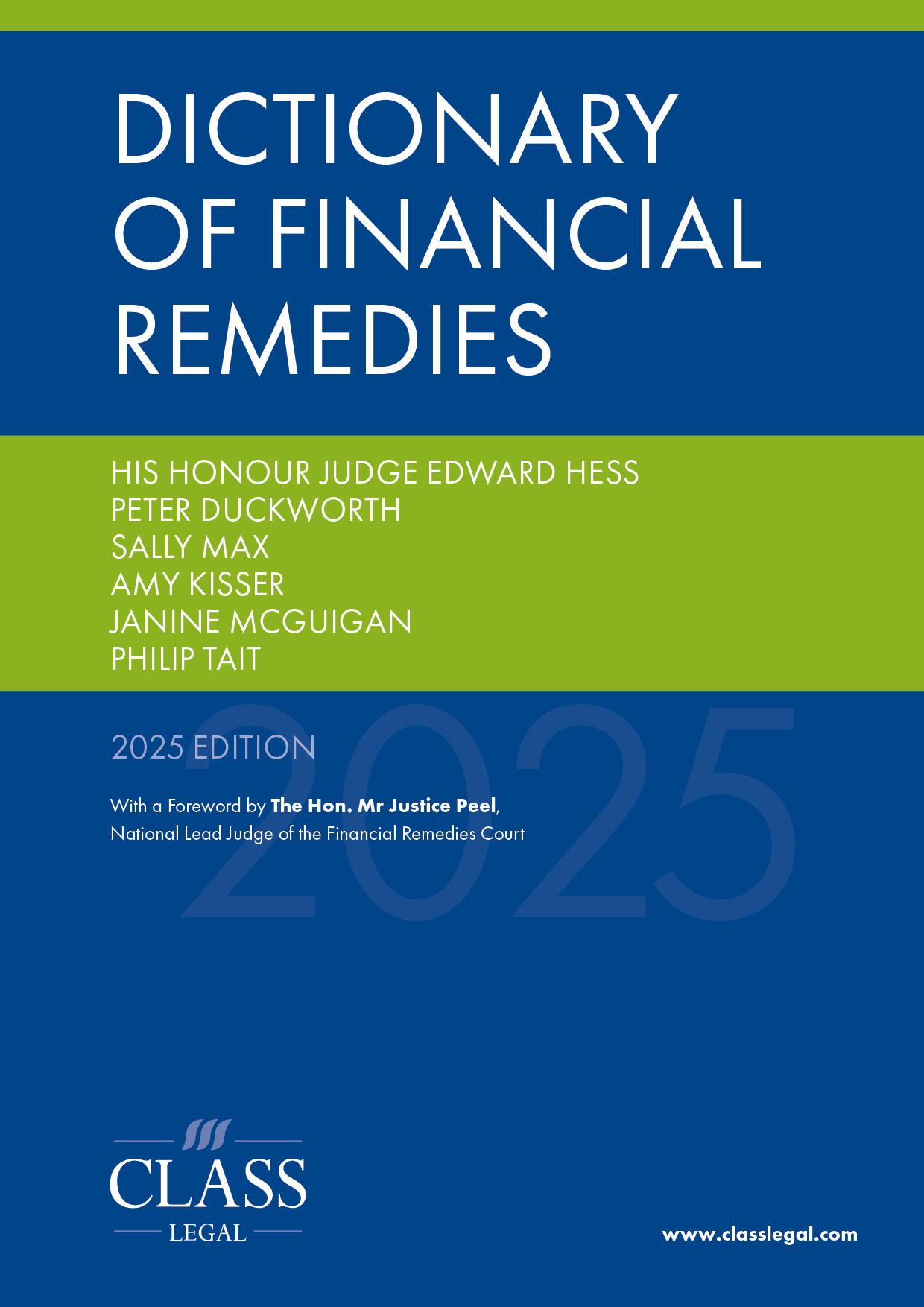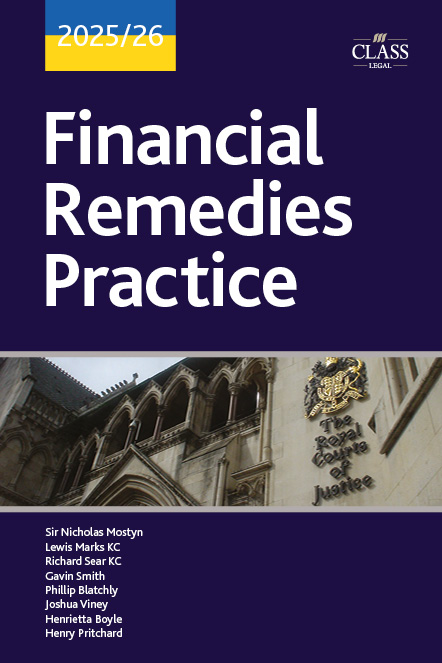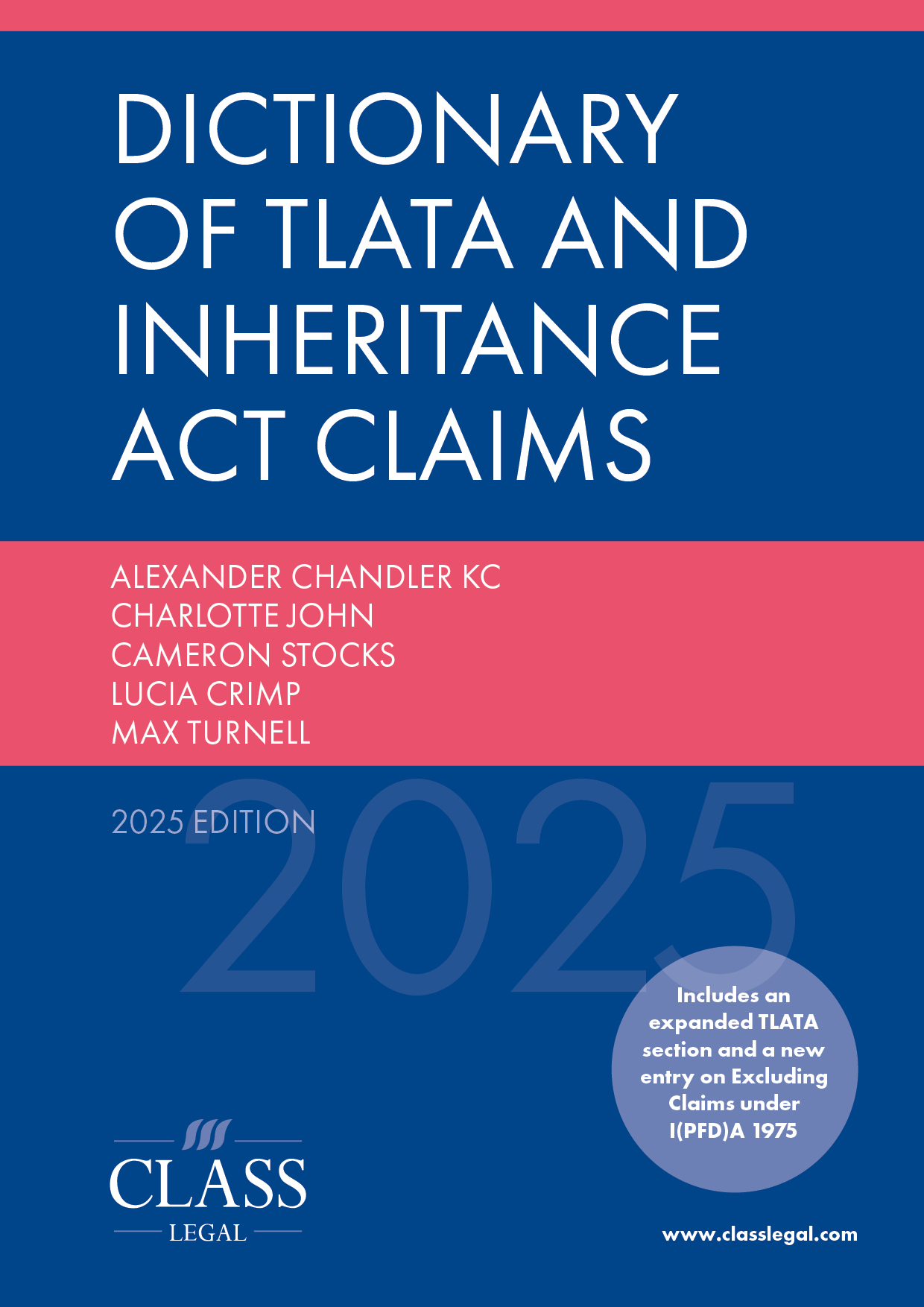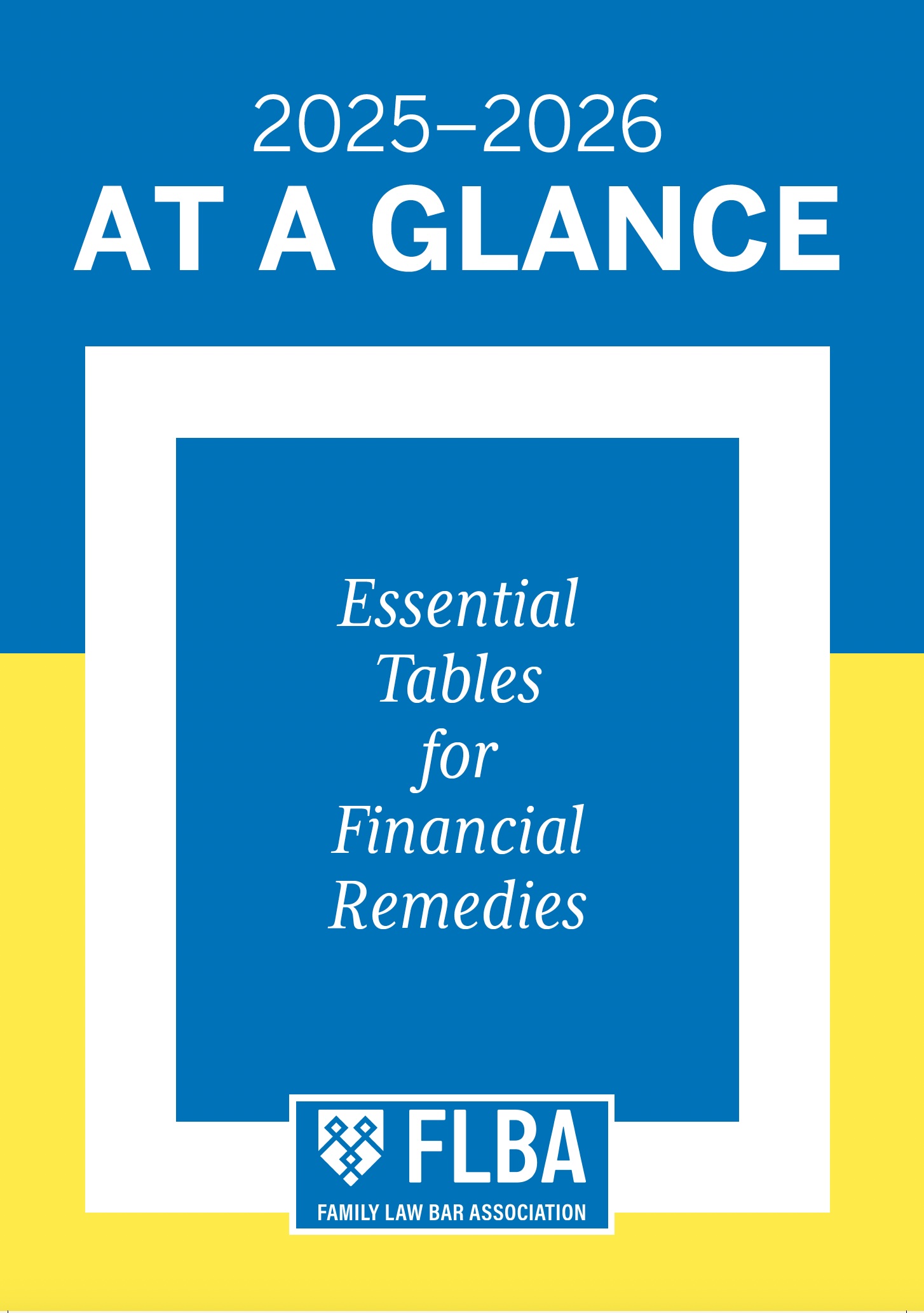
Financial Remedies – Next Steps on the Road to Reform?
Published: 18/03/2025 06:00

1.1 On 18 December 2024 the Law Commission published its Scoping Report on financial remedies on divorce and dissolution.1 The Scoping Report sets out our findings that the current law does not provide a cohesive framework in which couples going through a divorce can expect fair and sufficiently certain outcomes. Consequently, we conclude that the law is in need of reform. As our report is a Scoping Report, we do not make recommendations for how the law might be changed. Instead, the Scoping Report sets out four potential models on which any future reform of the law could be based. It is for Government to consider whether any of the models present a desirable route for reform. The Scoping Report also addresses whether there is scope for reform in relation to specific issues such as nuptial agreements, potential limits on spousal maintenance, and the treatment of conduct in financial remedies cases.
1.2 Our Scoping Report can be seen as a step on the road to reform, rather than the eventual destination. In this article, we consider in broad terms what the next steps on the road to reform might be. This will, of course, depend on the direction Government chooses to take in pursuing reform, assuming that it accepts our conclusion that reform is needed.
The direction reform might take
1.3 We set out below a brief summary of the four models we propose in our Scoping Report: codification, ‘codification-plus’, guided discretion and a default regime. We note the issues which would need to be considered were any particular model to be selected. Should Government select a model which would require more extensive reform, such as a default regime, the general questions any future project of law reform would need to ask, and the choices to be made, would be very different to those raised in a less extensive model, such as codification. We then look at the potential direction for reform of the specific issues which we consider in our Scoping Report (such as nuptial agreements or conduct).
Codification and codification-plus
1.4 Codification of existing principles would require a single policy decision to explicitly incorporate established case-law into the existing statutory framework of the Matrimonial Causes Act 1973. Consequently, it is not the substance of the law which is the focus of reform, but rather its presentation in a ‘cohesive framework’2 and more easily accessible format. Codification-plus to some extent has the same aim, but additionally enables law reform to be undertaken in specific areas.
1.5 Given that one of the criticisms of the current law is that it is not clear from the face of the statute how a court will exercise its discretion in interpreting the factors which are listed under s 25, codification would give greater clarity and transparency to the law. This would be particularly helpful for couples who do not obtain any legal advice, but it would also help to reduce the uncertainty and therefore potentially protracted litigation and associated costs of those who do seek legal advice. As we note in the impact section of our Scoping Report, any reform which makes the law more certain and reduces the likelihood of litigation benefits everyone.3
1.6 Codification of settled case-law would not by itself reduce the discretion that exists in the current law: the range of available orders coupled with the existing principles would maintain judicial flexibility to provide the most appropriate remedies for the couple before the court. Equally, however, it does nothing to resolve the uncertainty in the law that is currently difficult for couples to navigate (even with legal advice) and that provides a barrier to settlement.
1.7 Codifying the existing settled case-law would be the simplest approach to reform. The principles of fairness, needs and sharing could be embodied in any reformed statute. Sharing would be limited to matrimonial property as understood through the existing case-law. Non-matrimonial property would remain the property of the spouse who owned it unless it was required to meet the other spouse’s needs. The duration of the marriage would be deemed to include the preceding period of ‘seamless’ cohabitation; a point that would be relevant for determining the extent of the matrimonial property. Indeed, consideration of seamless cohabitation is an element of the current law which at present is not widely known to couples as it is a pure creature of the common law.
1.8 ‘Codification-plus’ has the similar aim of clarifying the current law, but in addition, it enables substantive reform which goes further than the existing case-law. For example, if the principle of meeting needs as currently understood through the case-law is codified, codification-plus would entail consideration of whether ‘needs’ should be defined on the face of the statute. Codification-plus would ultimately offer greater clarity on how the existing principles apply so that couples would be better equipped to negotiate a settlement.
1.9 In addition, codification-plus could introduce reform on specific, discrete issues which we considered in our Scoping Report. For example, binding nuptial agreements, spousal maintenance, provision for children aged 18 and over and the effect of domestic abuse in financial remedies outcomes could all be considered in the course of developing a codification-plus model. We return to these discrete issues below in more detail.
Guided discretion
1.10 By guided discretion, we mean the introduction of a set of underpinning principles and objectives which guide the exercise of the court’s discretion. This approach goes one step further than codification or codification-plus as it does not depend on s 25 MCA 1973 as a reference point. Under a guided discretion model, legislation sets out the purpose of financial remedies law and the principles which must guide the application of the law. It is intended to provide sufficient clarity in the legislation to help couples come to their own arrangements in the shadow of the law. It can nevertheless retain, to a greater or lesser extent, some judicial discretion, which can then be exercised on a case-by-case basis.
1.11 If Government decides to adopt a model of guided discretion, any future reform work would need to establish what the rules or principles underpinning any such model should be and identify the matters on which judicial discretion should remain. In our Scoping Report, we looked at existing examples of guided discretion models, such as those in operation in New Zealand and Scotland. We also considered the Divorce (Financial Provision) Bill to represent a guided discretion model. As we indicated in our Scoping Report, a guided discretion model can be devised to meet particular policy objectives. Hence if Government adopts this model, the approach taken need not reflect any of the existing examples of this approach. The substance of the model – the principles that guide the discretion – must reflect the socio-economic context and needs of the society which it serves. Equally, criticisms of the details of any examples of this model should not be seen as criticisms of the model itself.
1.12 As under a codification-plus model, Government could decide that a model of guided discretion should incorporate some of the specific, discrete issues which we considered in our Scoping Report, and to which we return below.
Default matrimonial property regime
1.13 In our Scoping Report, we also considered the adoption of a default matrimonial property regime model as an alternative reform option. Under this model, the law prescribes explicit rules which regulate the financial consequences of divorce from the date of the marriage. A matrimonial property regime will usually regulate the disposition and distribution of property both during the marriage and upon divorce. It is normally accompanied by a further set of rules (or ‘pillars’) which relate specifically to the question of spousal maintenance and to certain assets, such as the family home and pensions. Under a default matrimonial property regime there is less opportunity for the exercise of judicial discretion because the law sets out which property is to be divided, and on what basis. There is therefore generally greater certainty and much less need for couples to go to court to resolve their finances upon divorce. Importantly, in countries which operate default regimes, couples are able to ‘opt-out’ by concluding their own binding nuptial agreement.
1.14 If Government decides to introduce a default matrimonial property regime, such a regime could be developed to take into account the specific socio-economic context of England and Wales; it would not be simply a case of transplanting an existing regime from elsewhere.
1.15 Any future project of law reform to introduce a default regime would need to reach a conclusion as to whether:
(1) marriage should have an immediate effect on property rights by the creation of a ‘community of property’; or
(2) property should remain separate during the marriage but upon divorce should, at least in relation to certain types of property, be shared equally – a ‘deferred community of property’.
1.16 On either approach the question also arises as to whether any community property should be equally shared in all circumstances, or whether any reformed law should set out specified circumstances in which equal sharing should or could be departed from.
1.17 As part of our scoping work, and following publication, we heard views from stakeholders and commentators on the different models we identified. Some suggested that they thought the most likely choice for Government is between codification-plus and guided discretion.4 However, we also heard both support and opposition for each of the models and we believe that all four models offer viable alternatives to the current system. The choice will ultimately be dictated by any objectives and policy imperatives that Government identifies as core to a fair and accessible financial remedies law.
Reform of specific areas
1.18 As well as setting out the four models on which reform could be based, our Scoping Report considered whether reform is needed in relation to specific areas:
(1) Nuptial agreements.
(2) Spousal maintenance.
(3) Provision for children aged 18 and over.
(4) Conduct.
(5) Pensions.
1.19 Reform of these areas could form part of a model based on codification-plus, guided discretion or creation of a default regime. The treatment of these issues will inevitably be but one part of overall reform and how they are dealt with will depend on any objectives identified in the new model.
Nuptial contracts
1.20 Readers will be aware of our Report on Matrimonial Property, Needs and Agreements (MPNA) from 2014. The MPNA Report included recommendations for the introduction of ‘qualifying nuptial agreements’5 (QNAs). Under our recommendations, QNAs would be binding contracts which would be used to determine how the couple’s assets are divided on divorce, in place of using the law contained in the MCA 1973. However, our recommendations did not allow couples to contract out of meeting financial needs as then understood; it would still be open to a spouse to make a claim in this regard. Our recommendations set out various procedural safeguards to be complied with in order for an agreement to be a QNA.
1.21 Law reform to provide for enforceable nuptial agreements could take place under any of the models we put forward except a simple codification. Our recommendations in the MPNA Report provide a solid basis for reform, although we note that current developments in the understanding and application of needs through the case-law would require further consideration before being implemented. In particular, there would need to be consideration of whether and how needs may be differently interpreted in a nuptial agreement context, than they would otherwise be in a financial remedies application on divorce.
1.22 Should Government decide to adopt a default regime or guided discretion model, a law reform project would need to consider how nuptial agreements could be included as part of a reformed financial remedies law. Our analysis of the different models shows that nuptial agreements are a central feature in both,6 and the approach to their incorporation would be developed within the framework of the chosen model.
Spousal maintenance
1.23 The Terms of Reference for our scoping project included the express consideration of whether the law should provide a maximum duration for spousal maintenance. We explain in the Scoping Report that currently spousal maintenance orders generally tend to be time limited and that the court is likely to avoid the making of such an order if a capitalised lump sum can be paid instead. However, for the majority of couples, there will often not be sufficient capital assets to enable this and spousal maintenance may be the only way to achieve a fair outcome.
1.24 On a codification-plus model, consideration could be given to imposing a time limit on maintenance orders, whether in the form of a set period of time or upon the occurrence of an identified event.7 Any limit could be subject to an overriding consideration of meeting needs and/or contain exceptions. Under the guided discretion model or a default regime, the question of spousal maintenance will need to be dealt with according to the model’s objective.
1.25 Existing models and the Divorce (Financial Provision) Bill offer a variety of approaches and justifications. Whilst Scots law and the Divorce (Financial Provision) Bill suggest a maximum time limit (of 3 and 5 years, respectively), the New Zealand legislation does not. However, in practice, in New Zealand, maintenance orders tend to be for a relatively short period of time.8 Importantly, the justification and the interaction of maintenance with other provisions all differ between the jurisdictions, as does the level of discretion which can be exercised.
Provision for children aged 18 and over
1.26 Unlike in many other jurisdictions, the law in England and Wales does not provide for an upper age limit for financial support for children aged 18 and over, when made in the course of financial remedies claims.9 However, we found that there is inconsistency in how such children are provided for in court orders, and it is not clear what arrangements are made by couples themselves for their financially dependent adult children. Stakeholders raised with us the difficulties faced by the parent with whom the child lives, most often the more financially vulnerable parent. Where the resident parent is a victim-survivor of domestic abuse, we heard that it is less likely for the former spouses to agree ongoing financial support for children aged 18 and over.
1.27 Under the proposed models (except codification), consideration would need to be given as to whether explicit provision should be made for children aged 18 and over. Consideration would need to be given to whether, and if so on what basis, a financial remedies order for the spouse with whom the child continues to live into adulthood (assuming the child’s primary home remains with one parent) should be available, or whether an order should be made for the child directly. In addition, reform should address whether financial provision for children aged 18 and over should end when the child reaches a certain age, when a particular event occurs (such as completion of tertiary education), or until the child becomes financially independent. Such choices should result in more certain financial support for this cohort of children.
Conduct
1.28 Whilst our Scoping Report considers all forms of conduct that arise in financial remedies cases (including litigation misconduct, non-disclosure and ‘add-backs’) the area about which we heard most from stakeholders was personal misconduct. Recently, greater awareness and visibility of the effect of domestic abuse on spouses and their financial situation has bolstered calls for reform of the law to include consideration of domestic abuse in financial remedies outcomes.10 We heard from stakeholders that victim-survivors of abuse (who are predominantly female) suffer poor financial outcomes following divorce and that the financial consequences of domestic abuse should instead properly fall on the perpetrators. Whilst the current law enables consideration of the financial consequences of abuse through an assessment of the victim-survivor’s needs, there is a growing momentum for better support and better outcomes for such victim-survivors. Our Scoping Report identifies areas with which we believe any future law reform project should engage.
1.29 We suggest that law reform could provide greater clarity on the following issues:
(1) what forms of behaviour will be considered conduct (whether that be personal misconduct or litigation misconduct);
(2) the impact that conduct will have on a claim for financial remedies; and
(3) the process to be adopted when making an allegation of conduct.
1.30 Interestingly, in jurisdictions which operate a default regime, although there is some divergence between them on when conduct may be relevant for the grant of the divorce itself, most consider non-financial conduct irrelevant for the purposes of property division and entitlement to maintenance. However, misconduct which directly impacts the property available for division is often dealt with by express legislative provisions which detail the consequences of deliberate mismanagement or dissipation of community property.
Pensions
1.31 We know that pensions are considered by most as complicated and opaque, and their value is not fully recognised, or in some cases even acknowledged when couples divorce. There is a general consensus from stakeholders that any reform of financial remedies law should examine how pensions are currently treated on divorce.
1.32 The impact of inadequate pension consideration is felt principally by women who generally have lower pension savings, due to time out of the workplace often because they are the primary carers of young children. We have seen that this gender imbalance is particularly marked for women over the age of 50. Where pensions are considered, there is a tendency to ‘off-set’ the perceived value of the pension, often against a greater share of the equity in the family home. However, valuing a pension is complex, especially if it is a defined benefit scheme, and (in most cases) requires a professional expert report which can be costly. If spouses do not obtain a pension report, the value of the off-set may be underestimated and result in longer-term disadvantage into retirement. This approach therefore does not necessarily produce a fair outcome.
1.33 It is clear from those with whom we have spoken that proper re-evaluation of the current law and procedures is imperative, to ensure that pension division becomes easier for divorcing couples to understand and engage with. The key issue is whether pension sharing should become the default statutory position or at least, if s 25 is retained, whether there should be explicit mention of pensions in s 25 as one of the factors for consideration. If a default statutory position were to be adopted, should equal sharing of pensions be the starting point? We have seen in our scoping work that many jurisdictions provide specific legislation on pension sharing, or are planning to introduce such legislation. However, the accessibility and affordability of expert pension reports remains a crucial element in any reform.
Implications of any reform
1.34 As we note in our Scoping Report, some stakeholders with whom we engaged took the view that the current law, as developed by the courts, is sufficiently clear, and that lawyers are able to advise those going through divorce on the likely range of outcomes. However, as our scoping work and other research (notably the Fair Shares report11) has revealed, the majority of divorcing couples do not obtain legal advice and very few cases are resolved in front of a judge. Furthermore, evidence shows that the financial outcomes following divorce are much poorer for women, and especially mothers, under the current law.12
1.35 We are also aware of suggestions that any replacement of s 25 could result in increased litigation as divorcing couples seek to test the limits of any new legislation and that, at least for a time, the law would therefore be less certain.13 We suspect that, as at present, some cases will need to be decided by the courts. This may be because, for whatever reason, the couple simply cannot reach agreement, or there are disagreements over valuations. It may also be because the level of assets involved make it worthwhile to incur the risks of litigation, or because one party is litigating unreasonably, or for some other reason. If an aim of reform is to make the law more certain and to make it easier for the majority of couples to resolve the consequences of divorce without litigation where that is possible (bearing in mind that at present the majority do not go to court, or even consult a lawyer),14 that reform should not be abandoned because a minority will choose or find it necessary to litigate.
1.36 There may also be a short period where litigants seek to identify the limits of any new legislation – such as was seen in the cases exploring the concept of ‘exceptional’ or ‘stellar’ contributions in the years immediately following the House of Lords’ decision in White v White [2000] UKHL 54.15 However, we do not think that a possible short-term increase in litigation during a ‘settling in’ period for any new legislation can be a reason not to reform the law, where reform is required – such an argument could be raised in relation to any new legislation. To continue the analogy we used in the introduction to this article, it would be an unavoidable bump in the road, but not, in our view, sufficient to mean that road should not be taken. Insofar as challenges to the limits of any legislation are unavoidable and predictable, this underscores the need for more clarity in legislative drafting compared to the current position.
Next steps
1.37 Under the terms of the Law Commission’s Protocol agreed with the Lord Chancellor,16 the Minister for the relevant Department (in this case the Ministry of Justice) will provide an interim response as soon as possible, but within 6 months from the publication of our Scoping Report (June 2025). A full response must follow within 12 months of the report. Upon publication, Baroness Deech posed a written parliamentary question enquiring about Government’s plans to consider it.17 The response provided by Lord Ponsonby on 6 January indicated that Government ‘will carefully consider the details and will provide a response in due course’.18
1.38 We cannot speculate on whether, and if so when, Government will wish to pursue financial remedies reform. Changing the law governing the financial consequences arising from personal relationships can be controversial; previous law reform proposals, for example on the financial consequences of cohabitation breakdown and on nuptial contracts, have not, to date, been taken further.19 But problems with the law do not just go away: they need to be solved. And as we explain in our Scoping Report, the current state of the law on financial remedies has reached the stage where it may be argued to be contrary to the rule of law given the gulf between what the statute says and how the law is applied.
1.39 If Government agrees with our conclusion that reform is required, it could take that task forward itself. The Law Commission would, however, be well placed to carry out a future law reform project and it may be helpful if we offer here some indication of the process that we would follow if asked by Government to do so.
1.40 Any future work by the Law Commission would involve a public consultation; although this project engaged to an extent with the public, the scoping nature of our work meant that we were not able to hear from members of the general public to the same extent that is possible through a full consultation. It is important that any reform of the law is informed by the experiences of individuals who have been personally affected by the law.20 A public consultation enables us to test provisional proposals for law reform with a wide range of stakeholders to provide the strongest evidence base for any recommendations we might make.
1.41 Once Terms of Reference for a project are agreed, we would publish a consultation paper and would then normally consult for a period of 3 months. Following consultation, we would publish a final report which could include a draft bill to give effect to our recommendations.
1.42 Our Scoping Report sets out in broad and non-exhaustive terms the key issues that would need to be addressed for each of the four models we have identified. The scoping work encompasses, insofar as we could set them out at this stage, the policy choices, parameters and questions that those tasked with any future reform will need to consider. We look forward to Government’s response.










